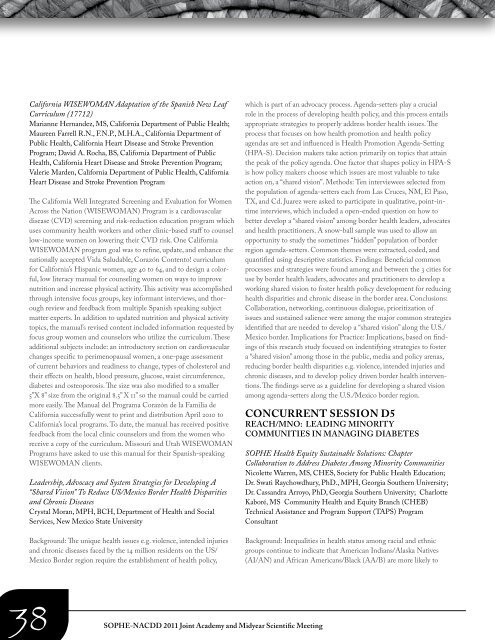to view the program - Society for Public Health Education
to view the program - Society for Public Health Education
to view the program - Society for Public Health Education
Create successful ePaper yourself
Turn your PDF publications into a flip-book with our unique Google optimized e-Paper software.
Cali<strong>for</strong>nia WISEWOMAN Adaptation of <strong>the</strong> Spanish New Leaf<br />
Curriculum (17712)<br />
Marianne Hernandez, MS, Cali<strong>for</strong>nia Department of <strong>Public</strong> <strong>Health</strong>;<br />
Maureen Farrell R.N., F.N.P., M.H.A., Cali<strong>for</strong>nia Department of<br />
<strong>Public</strong> <strong>Health</strong>, Cali<strong>for</strong>nia Heart Disease and Stroke Prevention<br />
Program; David A. Rocha, BS, Cali<strong>for</strong>nia Department of <strong>Public</strong><br />
<strong>Health</strong>, Cali<strong>for</strong>nia Heart Disease and Stroke Prevention Program;<br />
Valerie Marden, Cali<strong>for</strong>nia Department of <strong>Public</strong> <strong>Health</strong>, Cali<strong>for</strong>nia<br />
Heart Disease and Stroke Prevention Program<br />
The Cali<strong>for</strong>nia Well Integrated Screening and Evaluation <strong>for</strong> Women<br />
Across <strong>the</strong> Nation (WISEWOMAN) Program is a cardiovascular<br />
disease (CVD) screening and risk-reduction education <strong>program</strong> which<br />
uses community health workers and o<strong>the</strong>r clinic-based staff <strong>to</strong> counsel<br />
low-income women on lowering <strong>the</strong>ir CVD risk. One Cali<strong>for</strong>nia<br />
WISEWOMAN <strong>program</strong> goal was <strong>to</strong> refine, update, and enhance <strong>the</strong><br />
nationally accepted Vida Saludable, Corazón Conten<strong>to</strong>! curriculum<br />
<strong>for</strong> Cali<strong>for</strong>nia’s Hispanic women, age 40 <strong>to</strong> 64, and <strong>to</strong> design a colorful,<br />
low literacy manual <strong>for</strong> counseling women on ways <strong>to</strong> improve<br />
nutrition and increase physical activity. This activity was accomplished<br />
through intensive focus groups, key in<strong>for</strong>mant inter<strong>view</strong>s, and thorough<br />
re<strong>view</strong> and feedback from multiple Spanish speaking subject<br />
matter experts. In addition <strong>to</strong> updated nutrition and physical activity<br />
<strong>to</strong>pics, <strong>the</strong> manual’s revised content included in<strong>for</strong>mation requested by<br />
focus group women and counselors who utilize <strong>the</strong> curriculum. These<br />
additional subjects include: an introduc<strong>to</strong>ry section on cardiovascular<br />
changes specific <strong>to</strong> perimenopausal women, a one-page assessment<br />
of current behaviors and readiness <strong>to</strong> change, types of cholesterol and<br />
<strong>the</strong>ir effects on health, blood pressure, glucose, waist circumference,<br />
diabetes and osteoporosis. The size was also modified <strong>to</strong> a smaller<br />
5”X 8” size from <strong>the</strong> original 8.5” X 11” so <strong>the</strong> manual could be carried<br />
more easily. The Manual del Programa Corazón de la Familia de<br />
Cali<strong>for</strong>nia successfully went <strong>to</strong> print and distribution April 2010 <strong>to</strong><br />
Cali<strong>for</strong>nia’s local <strong>program</strong>s. To date, <strong>the</strong> manual has received positive<br />
feedback from <strong>the</strong> local clinic counselors and from <strong>the</strong> women who<br />
receive a copy of <strong>the</strong> curriculum. Missouri and Utah WISEWOMAN<br />
Programs have asked <strong>to</strong> use this manual <strong>for</strong> <strong>the</strong>ir Spanish-speaking<br />
WISEWOMAN clients.<br />
Leadership, Advocacy and System Strategies <strong>for</strong> Developing A<br />
“Shared Vision” To Reduce US/Mexico Border <strong>Health</strong> Disparities<br />
and Chronic Diseases<br />
Crystal Moran, MPH, BCH, Department of <strong>Health</strong> and Social<br />
Services, New Mexico State University<br />
Background: The unique health issues e.g. violence, intended injuries<br />
and chronic diseases faced by <strong>the</strong> 14 million residents on <strong>the</strong> US/<br />
Mexico Border region require <strong>the</strong> establishment of health policy,<br />
which is part of an advocacy process. Agenda-setters play a crucial<br />
role in <strong>the</strong> process of developing health policy, and this process entails<br />
appropriate strategies <strong>to</strong> properly address border health issues. The<br />
process that focuses on how health promotion and health policy<br />
agendas are set and influenced is <strong>Health</strong> Promotion Agenda-Setting<br />
(HPA-S). Decision makers take action primarily on <strong>to</strong>pics that attain<br />
<strong>the</strong> peak of <strong>the</strong> policy agenda. One fac<strong>to</strong>r that shapes policy in HPA-S<br />
is how policy makers choose which issues are most valuable <strong>to</strong> take<br />
action on, a “shared vision”. Methods: Ten inter<strong>view</strong>ees selected from<br />
<strong>the</strong> population of agenda-setters each from Las Cruces, NM, El Paso,<br />
TX, and Cd. Juarez were asked <strong>to</strong> participate in qualitative, point-intime<br />
inter<strong>view</strong>s, which included a open-ended question on how <strong>to</strong><br />
better develop a “shared vision” among border health leaders, advocates<br />
and health practitioners. A snow-ball sample was used <strong>to</strong> allow an<br />
opportunity <strong>to</strong> study <strong>the</strong> sometimes “hidden” population of border<br />
region agenda-setters. Common <strong>the</strong>mes were extracted, coded, and<br />
quantified using descriptive statistics. Findings: Beneficial common<br />
processes and strategies were found among and between <strong>the</strong> 3 cities <strong>for</strong><br />
use by border health leaders, advocates and practitioners <strong>to</strong> develop a<br />
working shared vision <strong>to</strong> foster health policy development <strong>for</strong> reducing<br />
health disparities and chronic disease in <strong>the</strong> border area. Conclusions:<br />
Collaboration, networking, continuous dialogue, prioritization of<br />
issues and sustained salience were among <strong>the</strong> major common strategies<br />
identified that are needed <strong>to</strong> develop a “shared vision” along <strong>the</strong> U.S./<br />
Mexico border. Implications <strong>for</strong> Practice: Implications, based on findings<br />
of this research study focused on indentifying strategies <strong>to</strong> foster<br />
a “shared vision” among those in <strong>the</strong> public, media and policy arenas,<br />
reducing border health disparities e.g. violence, intended injuries and<br />
chronic diseases, and <strong>to</strong> develop policy driven border health interventions.<br />
The findings serve as a guideline <strong>for</strong> developing a shared vision<br />
among agenda-setters along <strong>the</strong> U.S./Mexico border region.<br />
Concurrent Session D5<br />
REACH/MNO: Leading Minority<br />
Communities in Managing Diabetes<br />
SOPHE <strong>Health</strong> Equity Sustainable Solutions: Chapter<br />
Collaboration <strong>to</strong> Address Diabetes Among Minority Communities<br />
Nicolette Warren, MS, CHES, <strong>Society</strong> <strong>for</strong> <strong>Public</strong> <strong>Health</strong> <strong>Education</strong>;<br />
Dr. Swati Raychowdhury, PhD., MPH, Georgia Sou<strong>the</strong>rn University;<br />
Dr. Cassandra Arroyo, PhD, Georgia Sou<strong>the</strong>rn University; Charlotte<br />
Kaboré, MS Community <strong>Health</strong> and Equity Branch (CHEB)<br />
Technical Assistance and Program Support (TAPS) Program<br />
Consultant<br />
Background: Inequalities in health status among racial and ethnic<br />
groups continue <strong>to</strong> indicate that American Indians/Alaska Natives<br />
(AI/AN) and African Americans/Black (AA/B) are more likely <strong>to</strong><br />
38<br />
SOPHE-NACDD 2011 Joint Academy and Midyear Scientific Meeting

















